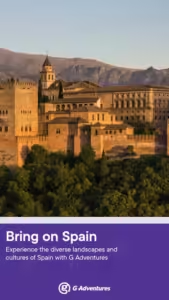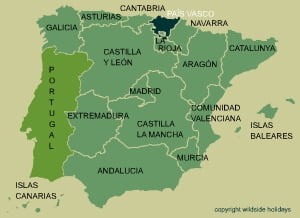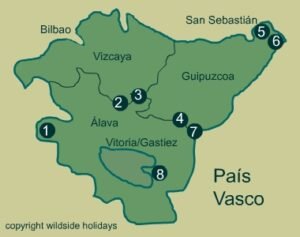Wildlife and walking holidays in País Vasco
- Capital: Gasteiz-Vitoria.
- Area: 7,234 km²
- Provinces 3: Viscaya, Guipuzcoa, Álava
The Basque Country is also known as Euskal Herria in the Basque Language, Pais Vasco in Spanish and Pays Basque in French.
Pais Vasco is separated from the French Basque Country by the Western Pyrenees mountain range.
The Bay of Biscay forms a coastal border in the north. The northern most region in Spain, it contains 19 main rivers.
The five most important rivers flowing into the Bay of Biscay in northern Spain are the Nervión, Bidasoa, Nalón, Sella, and Deva. The Nervión flows through the Basque Country, shaping Bilbao and its surroundings, while the Bidasoa forms a natural border with France, rich in biodiversity. The Nalón is Asturias’ longest river, supporting agriculture and industry, and the Sella is famed for its annual canoe race and beautiful scenery in Asturias. Finally, the Deva flows through Cantabria and Asturias, prized for its clean waters and salmon fishing.

Each river is crucial to the local ecosystem and culture, attracting tourism, supporting wildlife, and enhancing the region’s natural beauty.
The Celts, Romans and Christians had massive influence elsewhere on the Iberian peninsular but here the people have held on to their identity and language, Euskara.
From 1900 to 1970 mining minerals, steel works and ship building created a strong economy. This also brought with it an influx of Spaniards from other regions to take advantage of the boom and in turn has led to a bi-lingual language system.
This industry of the past is now reduced with fishing off the long coastal areas, farming in the mountainous parts and of course tourism dominating the economy of the region.
Find a hotel in the Basque country
The Basque Country offers a wide range of accommodation, from elegant beachfront hotels in San Sebastián to stylish city stays in Bilbao and peaceful rural guesthouses in the surrounding hills. Travellers can choose from luxury options near cultural landmarks like the Guggenheim Museum, family-run pensiones in historic seaside towns such as Hondarribia, and rustic agroturismos perfect for exploring natural parks. Check out places ideal for coastal walking here.
Whether you’re looking for a budget base for hiking, a romantic escape by the sea, or a centrally located hotel for tapas and museums, there’s something to suit every itinerary. Check out the options over at Booking.com
Tours in the Basque country from Viator
The basque country has a vast array of sites to visit and enjoy. Below are some of the options listed on the Viator website. (We recieve a small commission if you book a tour which doesn’t cost you more and helps us to keep Wildside Holidays up to date with the best information.)
Natural parks in the basque country
There are a number of Basque breeds and cultivars. These are animals that have been bred – or plant species cultivated – for particular traits and features by Basque people in the Basque Country. Read the fascinating article over at Wikipedia
- 1 The Valderejo Natural Park (Parque natural de Valderejo) is located in the extreme west of the municipality of Valdegovía (The Castilia y Leon area is also protected under the name of Montes Obarenes-San Zadornil Natural Park ). Access is from La Lastra where the Valderejo Natural Park Interpretation Center is located or from the town of Herrán (Burgos).
- 2 The largest protected area in País Vasco, Gorbeia Natural Park is formed around mount Gorbea and the altitude of this area gives it a typical mountain climate: the massif acts as a barrier that stops the humid winds that come from the bay of Biscay, which generates important differences between the north slope, more humid, and the south slope, more dry and sunny. Gorbeia has, consequently, an exceptional wealth of mountain ecosystems with a good state of conservation. See places to stay in Gorbeia here.
- 3 Urkiola Natural Park is located located in the southeastern corner of Biscay and Álava and within its limits lay the Aramotz, Duranguesado and Arangio mountain ranges. The landscape consists of limestone masses with steep slopes, gullies and cliffs. Karst plains support a diverse and rugged landscape consisting of different proportions of shrubs, grasses, rocks, beech and pine forests.
- 4 At almost 16,000 hectares, the Aizkorri-Aratz Natural Park (Parque natural de Aizkorri-Aratz) is the second-largest protected area in the Basque Country. This is a beautiful mountain area that links (in the form of a mountain corridor) the Pyrenees to the Cantabrian Mountains and here we can find the highest peaks of País Vasco (Aitxuri at 1,551 metres and Aizkorri at 1,544 metres). Find places to stay near to Aizkorri – Aratz here.
- 5 The relatively small protected area of the Pagoeta Natural park is formed by two estates, Pagoeta and Altzola which belong to the Provincial Council of Guipúzcoa. The objective was to create a forestry experimentation area and enhance its natural value, restoring its hardwood stands and protecting its fauna and flora. It is located close to the coast and just 20 km from San Sebastián.
- 6 The Peñas de Aya Natural Park (Aiako Harria in Basque). From Roman times, ore such as silver bearing galena and lead was extracted from the Arditurri mines making them one of the most important ancient mines in Hispania along with Las Médulas mines in Leon and those of Cartagena or Rio Tinto. The mines were abandoned by the Romans in the 5th century, but were exploited again from the Middle Ages until the 1980’s for iron ore making them among the very few in Spain that have been in use for over 2,000 years almost without interruption.
- 7 In the Sierra de Aralar Natural Park between May and November, livestock, especially latxa sheep which provide the milk for Idiazabal cheese, dairy cattle and herds of wild horses graze the area whilst durng the winter months livesock is kept closer to the small villages in the area.
- 8 Located 31 kms from Vitoria-Gasteiz, Izki Natural Park is a vast forest area surrounding the Izki river and flanked by mountains on either side. Standing at 1,176 m, Kapildui is the highest peak and the area is home to Europe’s largest Quercus pyrenaica woodland, covering around 3,500 hectares. There are also wide areas of beech, Portuguese oak, silver birch, English oak and holm oak populations.
The Armañón Natural Park is the ninth and most recently declared protected area in the Basque country. Located in the region of Las Encartaciones in Vizcaya here you will find the Torca del Carlista cave which is one of the the largest underground systems in Europe and a refuge for the main breeding colony of the Mediterranean horseshoe bat.
Looking for guided or self guided walking in Pais Vasco?

Walking North Spain are located in San Sebastian in the heart of a fantastic area for holidays and mountain travel, trips and routes are arranged in most of northern Spain (Basque Country, Navarra, Western Pyrenees, La Rioja, Picos de Europa…), as well as in the French Basque Country and the French Pyrenees. https://wildsideholidays.co.uk/walking-north-spain/
Frequently Asked Questions about Walking and Wildlife Holidays in the Basque Country
The Basque Country, or País Vasco, is a distinct cultural region in northern Spain, bordering France to the northeast and the Bay of Biscay to the north. It’s made up of three provinces: Álava (home to the capital Vitoria-Gasteiz), Bizkaia (with the city of Bilbao), and Gipuzkoa (featuring the resort city of San Sebastián). The region is separated from the French Basque Country by the Western Pyrenees, giving it both mountainous terrain and coastal access. This location shapes its unique biodiversity, climate, and cultural traditions.
Walking holidays here offer a blend of nature, history, and culture. You can hike through forest-covered mountains, explore limestone ridges, and visit UNESCO-listed cities all in one trip. Many routes pass through protected natural parks, offering well-marked trails and local wildlife. You’ll also encounter prehistoric cave art, Roman roads, and Basque farmhouses. For those seeking coastal views, the Flysch Cliffs Route near Zumaia is a must. Inland, the Sierra de Aralar and Gorbeia Natural Park offer a rugged landscape rich in flora and fauna.
Wildlife varies with the landscape. In mountain parks like Aralar or Aizkorri-Aratz, you’ll find griffon vultures, wild boar, and roe deer. The latxa sheep are iconic, producing the milk for Idiazabal cheese. In forests like Izki, look for woodpeckers, red squirrels, and Europe’s largest stretch of Pyrenean oak. Rivers such as the Bidasoa and Nervión support amphibians, fish, and bird species. If you’re near the coast, especially around Urdaibai Biosphere Reserve, expect to see marshland birds and sometimes even ospreys.
There are nine major protected areas in the Basque Country, each with its own character:
Gorbeia Natural Park: The largest, known for high peaks, caves, and contrasting moist northern vs dry southern slopes.
Aizkorri-Aratz: Home to País Vasco’s highest peaks; ideal for serious hikers.
Urkiola: Offers dramatic limestone cliffs and dense forest trails.
Izki: A forest haven with ancient oaks and rare species—great for birdwatchers.
Valderejo: Less crowded, great for quiet nature hikes and vultures.
Pagoeta: Close to the coast, with botanical interest and traditional Basque farming culture.
Peñas de Aya: Rich in mining history and geological interest.
Sierra de Aralar: Known for transhumant grazing, wild horses, and scenic trails.
Armañón: The newest park, notable for karst caves and fossil-rich geology.
Each park is accessible by road and most have interpretation centres, marked trails, and info boards in Basque, Spanish, and sometimes English.
Absolutely. The region’s mix of mountains, coastline, forests, and rivers means there’s always something to explore. You can walk in complete silence across ancient highland pastures or watch seabirds on coastal cliffs. The geography changes quickly—from alpine valleys to rocky coves—so the variety keeps things interesting. Nature lovers will also appreciate the sustainable tourism ethos here: many rural stays and tours are eco-certified, and local guides are knowledgeable about geology, birds, and botany.
Basque culture is unique in Spain. The language, Euskara, is unrelated to any other in Europe and still spoken widely. The region has preserved its identity through centuries of resistance to outside influence. Food is central—pintxos, seafood, and cured meats dominate, and there’s a strong focus on seasonal, local produce. Festivals, sports (like pelota), and traditional music also thrive. Urban centres like Bilbao mix modern design (Guggenheim Museum) with historic quarters, while villages in Álava and Gipuzkoa showcase rural life and age-old customs.
Yes. The Basque Country has a wide range of rural accommodations, from agroturismos (farm stays) and converted monasteries to eco-lodges and forest cabins. Many are located near natural parks or walking trails. For example:
Stay in Zeanuri to access Gorbeia.
Use Oñati as a base for Aizkorri-Aratz.
Choose a guesthouse in Getaria or Zumaia for coastal trails.
Most places offer hearty Basque meals, local wine, and insider tips from hosts. Booking.com and local tourism boards list many of these properties, and Viator provides tours nearby.
About the author of this article.
I’ve been living in this lovely area of Western Andalucia for the last 20 years or so and dedicate most of my time to the running of English language tourist information websites for the towns of Cádiz, Ronda, Grazalema, the famous or infamous Caminito del Rey, and also Wildside Holidays, which promotes sustainable and eco-friendly businesses running wildlife and walking holidays in Spain.



